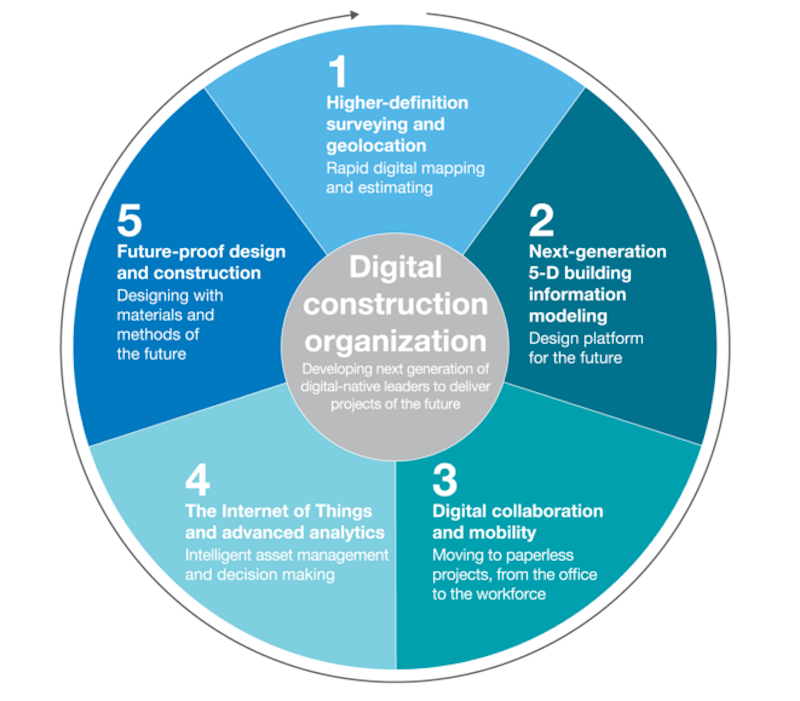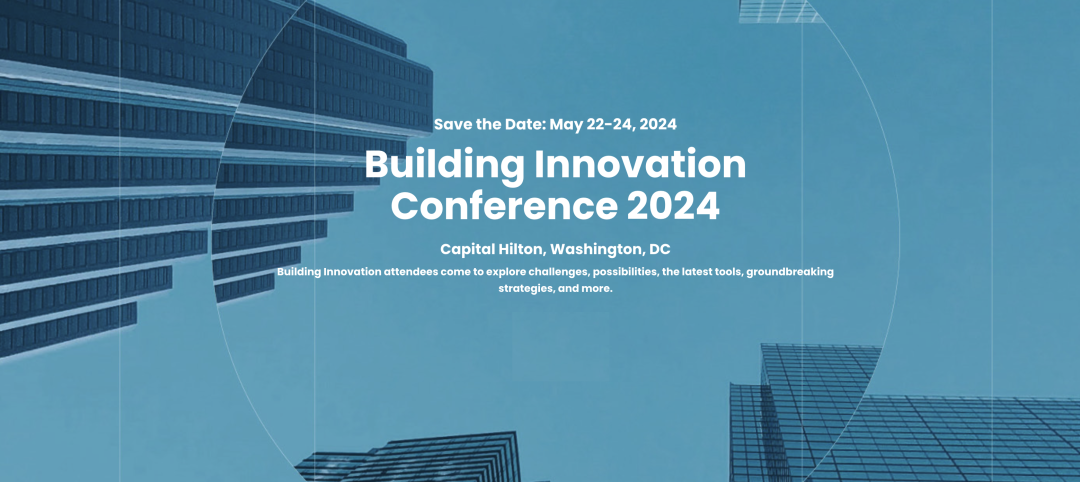Is the construction industry up to the challenge of repairing the world’s crumbling infrastructure? A new report from McKinsey & Co. answers with a definitive “No,” unless the industry can place itself firmly into the digital future in its organization, documentation, management, and information sharing.
The think tank estimates that the world will need to spend $57 trillion on infrastructure by 2030 just to keep pace with global economic growth. A recent report by three of its researchers also sees a construction industry that takes 20% longer than scheduled to finish most projects that come in up to 80% over budget.
“Construction productivity has actually declined in some markets since the 1990s,” writes the report’s authors, Rajat Agarwal, Shankar Chandrasekaran, and Mukund Srishar, in an article they posted last month. “The construction industry is ripe for disruption.”
Such observations are hardly new; there have been myriad other reports that lament the same problems in the construction sector, and fret about how massive reconstruction can possibly be accomplished.
What makes this paper a little different is that the “five big ideas” proposed by its authors aren’t at all futuristic.

Five trends that are making the construction process run smoother and quicker. Image: McKinsey & Co.
The authors basically believe that the construction industry needs to be reorganized around digital technology, including:
•Higher-definition surveying and geolocation
•Next-generation 5D BIM
•Digital collaboration and mobility
•The Internet of Things (IoT), coupled with advanced analytics
•Future-proof design and construction with sustainable materials and methods.
Within these trends, McKinsey sees LIDAR as “an evolution in surveying,” primarily because of breakthroughs in drone technology and handheld platforms.
Five-D BIM goes beyond 3D BIM by taking into account a project’s cost and schedule. “The visual and intuitive nature of 5D BIM gives contractors a better chance to identify risk earlier, and thus to make better decisions.” Augmented reality technology will further enhance the effectiveness of 5D BIM, which project owners and contractors “need to incorporate right from the design stage.”
McKinsey revisits the need for the construction sector to move aggressively toward online communication as a way of improving productivity. Paper, the report argues, makes data analysis among team members tougher, and is subject to being mismanaged among different stakeholders.
By comparison, the authors point to an American tunnel project that involved 600 vendors, for which the contractor developed a single platform for bidding, tendering, and contract management. “This saved the team more than 20 hours of staff time per week, and cut down the time to generate reports by 75%,” they write.
Perhaps more to the point, the digital-collaboration and mobility solutions segments have attracted close to 60% of all venture capital funding in the construction-technology sector.
The report also suggests several advantageous potential uses for IoT working in combination with sensors and near-field-communication devices. These uses include equipment monitoring and repair, inventory management and ordering, quality assessment, energy efficiency (such as sensors monitoring ambient conditions and fuel consumption of equipment), and safety.
As for future proofing projects, the report lists a host of new building materials—self-healing concrete, aerogels, nanomaterials—and construction approaches—like 3D printing and preassembled modules—that could lower cost and speed up the construction process.
“Some of these ‘materials of the future’ could redefine how projects are conceptualized, designed, and executed,” states the report. It notes, however, that adoption of these materials has been slowed by a lack of awareness and availability, limited supply chain, and the industry’s risk aversion.
While 80% of all construction work is still done on-site, more project developers and contractors are deploying off-site approaches “that help them improve predictability, consistency, and repeatability.” These approaches include preassembly of components and simply structures, 3D printing, and robot-assembled construction.
None of these recommendations will surprise any nonresidential contractor. The question, though, is why aren’t these ideas being implemented more widely? The McKinsey authors say the industry needs “to adopt a new mindset” whose foundation is shared responsibility, and has four principles:
•Transparency and risk sharing in contracts
•Return-on-investment orientation
•Simplicity and intuitiveness in the design of new solutions
•Change management (as in top management communicating clearly why changes are important)
Project owners and developers need to mandate the adoption of digital technologies and measure results. This should include appointing a Chief Technology Officer or Chief Innovation Officer who can think boldly about the company’s digital agenda.
Engineers and contractors need to develop “digital road maps” for project management. “And it’s important to ensure that project teams have the budgets and authority they need to pilot new technologies. It’s essential to build the capabilities of project managers so they can become digitally adept.”
Related Stories
Contractors | May 1, 2024
Nonresidential construction spending rises 0.2% in March 2024 to $1.19 trillion
National nonresidential construction spending increased 0.2% in March, according to an Associated Builders and Contractors analysis of data published today by the U.S. Census Bureau. On a seasonally adjusted annualized basis, nonresidential spending totaled $1.19 trillion.
K-12 Schools | Apr 30, 2024
Fully electric Oregon elementary school aims for resilience with microgrid design
The River Grove Elementary School in Oregon was designed for net-zero carbon and resiliency to seismic events, storms, and wildfire. The roughly 82,000-sf school in a Portland suburb will feature a microgrid—a small-scale power grid that operates independently from the area’s electric grid.
AEC Tech | Apr 30, 2024
Lack of organizational readiness is biggest hurdle to artificial intelligence adoption
Managers of companies in the industrial sector, including construction, have bought the hype of artificial intelligence (AI) as a transformative technology, but their organizations are not ready to realize its promise, according to research from IFS, a global cloud enterprise software company. An IFS survey of 1,700 senior decision-makers found that 84% of executives anticipate massive organizational benefits from AI.
Codes and Standards | Apr 30, 2024
Updated document details methods of testing fenestration for exterior walls
The Fenestration and Glazing Industry Alliance (FGIA) updated a document serving a recommended practice for determining test methodology for laboratory and field testing of exterior wall systems. The document pertains to products covered by an AAMA standard such as curtain walls, storefronts, window walls, and sloped glazing. AAMA 501-24, Methods of Test for Exterior Walls was last updated in 2015.
MFPRO+ News | Apr 29, 2024
World’s largest 3D printer could create entire neighborhoods
The University of Maine recently unveiled the world’s largest 3D printer said to be able to create entire neighborhoods. The machine is four times larger than a preceding model that was first tested in 2019. The older model was used to create a 600 sf single-family home made of recyclable wood fiber and bio-resin materials.
AEC Innovators | Apr 26, 2024
National Institute of Building Sciences announces Building Innovation 2024 schedule
The National Institute of Building Sciences is hosting its annual Building Innovation conference, May 22-24 at the Capital Hilton in Washington, D.C. BI2024 brings together everyone who impacts the built environment: government agencies, contractors, the private sector, architects, scientists, and more.
Contractors | Apr 26, 2024
AGC releases decarbonization playbook to help assess, track, reduce GHG emissions
The Associated General Contractors of America released a new, first-of-its-kind, decarbonization playbook designed to help firms assess, track, and reduce greenhouse gas emissions on projects. The AGC Playbook on Decarbonization and Carbon Reporting in the Construction Industry is part of the association’s efforts to make sure construction firms play a leading role in crafting carbon-reduction measures for the industry.
Mass Timber | Apr 25, 2024
Bjarke Ingels Group designs a mass timber cube structure for the University of Kansas
Bjarke Ingels Group (BIG) and executive architect BNIM have unveiled their design for a new mass timber cube structure called the Makers’ KUbe for the University of Kansas School of Architecture & Design. A six-story, 50,000-sf building for learning and collaboration, the light-filled KUbe will house studio and teaching space, 3D-printing and robotic labs, and a ground-level cafe, all organized around a central core.
Senior Living Design | Apr 24, 2024
Nation's largest Passive House senior living facility completed in Portland, Ore.
Construction of Parkview, a high-rise expansion of a Continuing Care Retirement Community (CCRC) in Portland, Ore., completed recently. The senior living facility is touted as the largest Passive House structure on the West Coast, and the largest Passive House senior living building in the country.
Hotel Facilities | Apr 24, 2024
The U.S. hotel construction market sees record highs in the first quarter of 2024
As seen in the Q1 2024 U.S. Hotel Construction Pipeline Trend Report from Lodging Econometrics (LE), at the end of the first quarter, there are 6,065 projects with 702,990 rooms in the pipeline. This new all-time high represents a 9% year-over-year (YOY) increase in projects and a 7% YOY increase in rooms compared to last year.

















